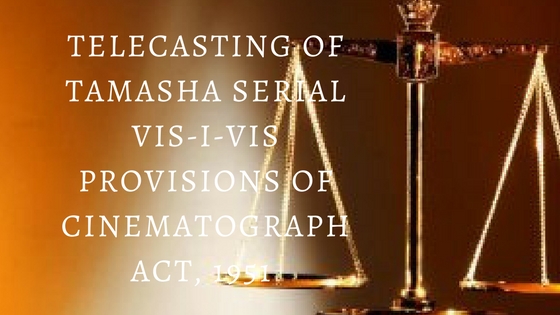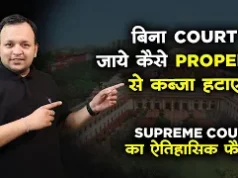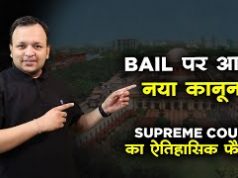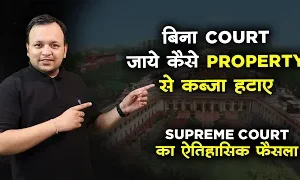Aapka Consultant Judgment Series- In this series, we are providing case analysis of Landmark Judgments of Hon’ble Supreme Court of India.
Ramesh s/o Chotalal Dalal Vs. Union of India (UOI) and Ors.
AIR 1988 SC 775, 1988 (1) SCALE 327, (1988) 1 SCC 668, [1988] 2 SCR 1011
Hon’ble Judges/Coram: Sabyasachi Mukherjee, JJ. and S. Ranganathan
Date of Decision: 16.02.1988
FACTS: –
The petitioner approached this Court by means of the petition under Article 32 of the Constitution for issue of a writ in the nature of Prohibition or any other appropriate order restraining the respondents from telecasting or screening the serial titled “Tamas” and to enforce petitioner’s fundamental rights under the Constitution and declaring the Screening or televising of “Tamas” as violative of Section 5B of the Cinematograph Act, 1952. The petitioner states that the exhibition of the said serial is against public order and is likely to incite the people to indulge in the commission of offences and it is therefore, violative of Section 5B(1) of the Cinematograph Act, 1952 (hereinafter called ‘the Act’) and destructive of principle embodied under Article 25 of the Constitution. It is also contended that this is also violative of Section 153A of the Indian Penal Code and the serial is prejudicial to the national integration.
ISSUE: –
Whether Tamasha serial is in violation of section 5B of the Cinematograph Act, 1952 resulting in the violation of the fundamental right of the petitioner under Article 21 and 25 of the Indian constitution?
JUDGMENT: –
“Tamas” is based on a book written by Sree Bhisham Sahni. It depicts the period prior to partition and how communal violence was generated by fundamentalists and extremists in both Hindu and Muslim communities and how innocent persons were duped into serving the ulterior purpose of fundamentalists and communalists of both sides and how an innocent boy is seduced to violence resulting in his harming both communities. It further shows how extremist elements in both communities infused tension and hatred for their own ends. In the end, realisation ultimately dawns as to the futility of it all and finally how inherent goodness in human mind triumphs and both communities learn to live in amity. Above mentioned is the opinion, as they see the serial, of the two judges of Bombay High Court.
“Tamas” had been given ‘U’ certificate by the Central Board of Film Censor. Cinematograph Act, 1952, is an Act to make provision for the certification of cinematograph films for exhibition and regulating exhibitions by means of cinematograph. Section 3 of the Act provides for Board of Film Censors. Section 4 of the Act provides for examination of films. A film is examined in the first instance by an Examining Committee under Section 4A and, in certain circumstances, it is further examined by a Revising Committee under Section 5. Members of both the Committees are expected to set out not only their recommendations but also the reasons therefore in cases where there is difference of opinion amongst the members of the Committee. Section 5A of the Act provides that if after examining a film or having it examined in the prescribed manner, the Board considers that the film is suitable for unrestricted public exhibition, such a certificate is given which is called ‘U’ certificate. Section 5B of the Act provides for guidance in certifying films.
The standards that set for censors must make a substantial allowance in favour of freedom thus leaving a vast area for creative art to interpret life and society with some of its foibles along with what is good. We must not look upon such human relationship as banned in toto and forever from human thought and must give scope for talent to put them before society. In our scheme of things ideas having redeeming social or artistic value must also have importance and protection for their growth.
The Cinematograph Act itself contains several provisions to ensure the fulfilment of the conditions laid down in Section 5B and to ensure that any film which is likely to offend the religious susceptibilities of the people are not screened for public exhibition of the film. Moreover, the Doordarshan authorities also scrutinise a film before it is exhibited on the television screen. The procedure does involve further examination of the film from standards of public acceptability before it is shown on the television. It is true that the remedy of an approach to the Appellate Tribunal is available only to persons aggrieved by the refusal of the Board to grant a certificate or the cuts and modifications proposed by it. It is for the consideration of the Central Government whether the scope of this section should be expanded to permit appeals to the Tribunals even by persons who are aggrieved by the grant of certificate of exhibition to a film on the ground that the principles laid down for the grant of certificates in Section 5B have not been fulfilled. But, even on the statute as it presently stands, the procedure for grant of certificate of exhibition to a film is quite elaborate and the unanimous approval by the examining Committee must be given full weight.
Tamas takes us to a historical past -unpleasant at times, but revealing and instructive. In those years which Tamas depicts a human tragedy of great dimension took place in this subcontinent – though 40 years ago – it has left a lasting damage to the Indian psyche. This is also the lesson of history that naked truth’ in all times will not be beneficial but truth in its proper light indicating the evils and the consequences of those evils is instructive and that message is there in “Tamas” according to the views expressed by the two learned Judges of the High Court. They viewed it from an average, healthy and commonsense point of view. That is the yardstick. There cannot be any apprehension that it is likely to affect public order or it is likely to incite into the commission of any offence. On the other hand, it is more likely that it will prevent incitement to such offences in future by extremists and fundamentalists. What is necessary sometimes is to penetrate behind the scenes and analyse the causes of such conflicts. The attempt of the author in this film is to draw a lesson from our country’s past history, expose the motives of persons who operate behind the scenes to generate and foment conflicts and to emphasise the desire of persons to live in amity and the need for them to rise above religious barriers and treat one another with kindness, sympathy and affection.
HELD: –
Taking the film in its entirety, it cannot be considered to be in violation of the provisions of the Cinematographic Act and thereby, resulting in the violation of the fundamental rights of the petitioner.
To Get Legal Opinion from Advocates/ Legal Experts, Please click here
To Get Legal Opinion from Retired Hon’ble Judges, Please click here












